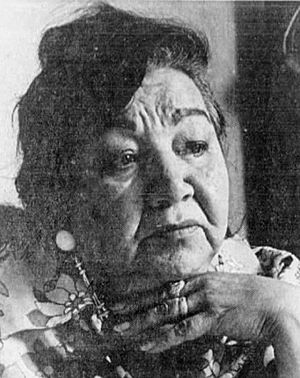Belva Cottier facts for kids
Belva Cottier (June 27, 1920 – May 2, 2000) was an important American activist and social worker. She was a member of the Rosebud Sioux tribe. Belva Cottier worked to improve the lives of Native Americans.
She is well-known for suggesting the idea of taking over Alcatraz Island in 1964. She helped lead protests to give the island back to Native Americans. She also helped plan the first Alcatraz occupation. Later, she became the director of the first American Indian Health Center in the Bay Area in 1972. This center helped Native Americans living in cities get better healthcare.
Contents
Early Life and Education
Belva Dale McKenzie was born on June 27, 1920. Her birthplace was the Rosebud Indian Reservation in Todd County, South Dakota. Her mother was from the Santee Sioux tribe. Her father was Lakota and a member of the Rosebud Sioux.
Belva's father passed away when she was five years old. After that, she and her mother lived on different reservations. Belva went to boarding schools and public schools. She graduated from Pine Ridge Boarding School in 1941. That same year, she married Allen Louis Cottier, who was an Oglala Sioux.
Working for Native American Rights
During World War II, Belva Cottier's husband joined the Navy. In 1943, Belva moved to Alameda County, California with her mother and two daughters. They later had another daughter.
After a law called the Indian Relocation Act of 1956 was passed, Belva became very active. She worked to help Native Americans who had moved to cities. She was also the secretary of the Sioux Club in the Bay Area.
The Idea of Alcatraz
In 1963, the government announced a plan. They would close the Alcatraz Federal Penitentiary. They would give Alcatraz Island back to the City of San Francisco. Belva Cottier had an idea. She thought Native Americans could claim the island. This idea was based on the 1868 Treaty of Fort Laramie.
Belva believed the treaty meant that lands once belonging to the Sioux should return to them. This would happen if the lands were no longer needed by the government. She and her cousin, Richard McKenzie, searched for a copy of the treaty. They found one at the Bancroft Library.
First Alcatraz Occupation Attempt
Belva and her husband, Allen Cottier, contacted a lawyer named Elliott Leighton. He studied the treaty and agreed with their idea. On March 4, 1964, Allen Cottier led a group of five Sioux men to Alcatraz. They planned to claim the island. About 35 other people, including Belva, joined them. They brought enough food for 30 days.
The group placed wooden stakes on the island. They filled out claim forms for the land. However, the acting warden of Alcatraz arrived. He told them they were trespassing and could face charges. Their lawyer advised them to leave. The group left after being on the island for four hours.
Legal Fight for Alcatraz
Three weeks later, Belva Cottier led a new effort. She wanted to claim the island through the courts. On March 27, Belva and other Sioux leaders filed a lawsuit. They asked the government to give them the island. Their goal was to create a Native American university there.
However, the court ruled against them. The court said a 1934 law stopped Native Americans from claiming unused government land. Even though the 1868 Sioux treaty had special rules, the court said the Sioux never owned Alcatraz. So, it could not be given back to them. The government gave the island to another agency. But Belva Cottier's efforts were remembered. Her work helped inspire the larger Occupation of Alcatraz in 1969.
Helping Urban Native Americans
In 1967, Belva Cottier started working as a volunteer. She was a counselor at the Oakland American Indian Association. She helped Native Americans with social services. She also drove them to appointments. In 1969, she became a paid employee there.
That same year, she met Richard Oakes. She advised him and other students. They were planning a second occupation of Alcatraz.
In 1970, the Urban Indian Health Board was created. Its goal was to help Native Americans in the San Francisco Bay area. Belva Cottier led a study of families in the area. This study showed the health needs of Native Americans.
Her study helped create the Native American Health Center in San Francisco. It opened in 1972. Belva Cottier became its executive director. The center mainly served Native Americans. But it also helped other patients. During the Wounded Knee Occupation, Belva collected donations. She made sure supplies reached the Pine Ridge Indian Reservation.
In 1972, Belva helped organize a conference. It brought together Native Americans from cities and reservations. They discussed their needs and the fight for equality. Belva believed that unemployment and feeling alone were big problems for Native Americans in cities. In 1975, Belva married James W. Satterfield. She continued working at the Native American Health Center into the 1980s.
Death and Legacy
Belva Cottier passed away at her home in Livermore, California. This was on May 2, 2000. She was buried on May 9 at the Golden Gate National Cemetery in San Bruno, California. People remember her for her strong work and activism. She helped improve the lives of Native Americans.
See also
 In Spanish: Belva Cottier para niños
In Spanish: Belva Cottier para niños


